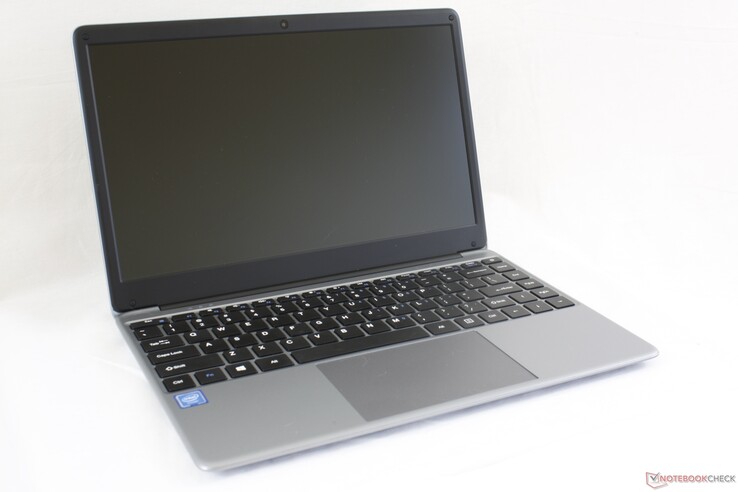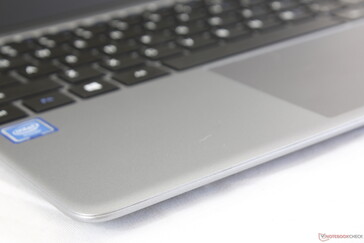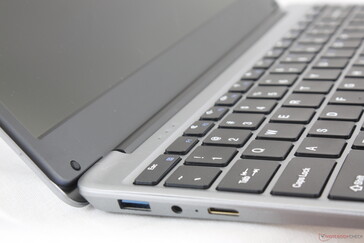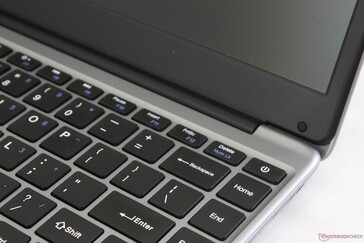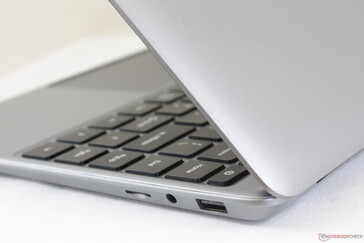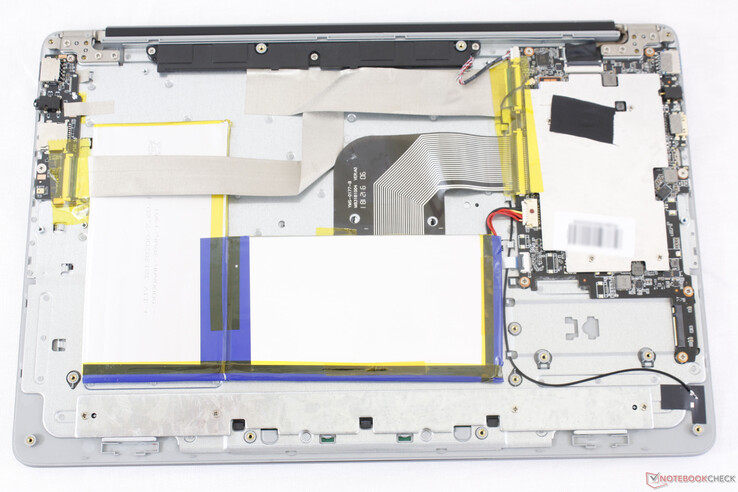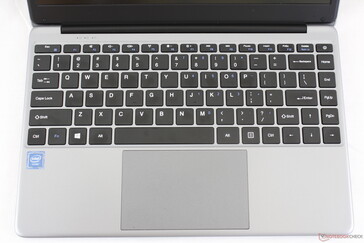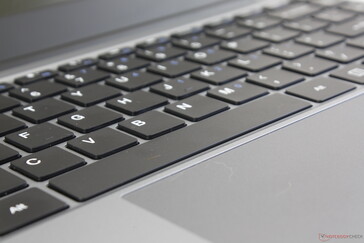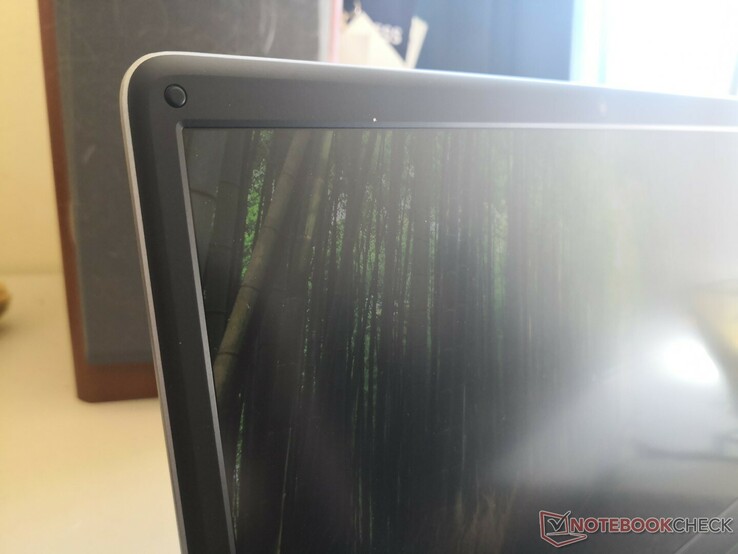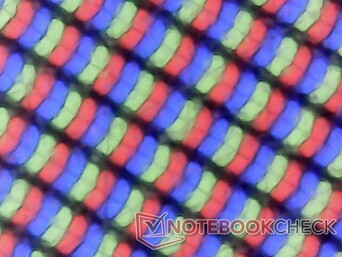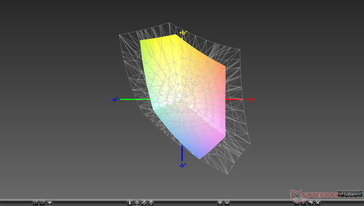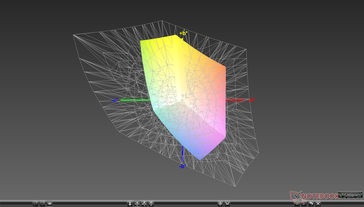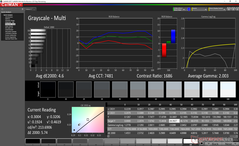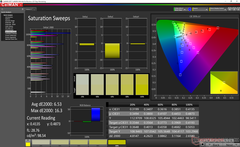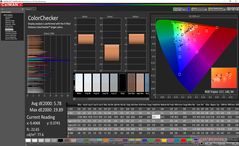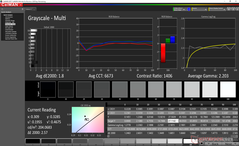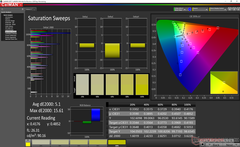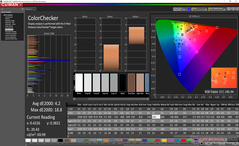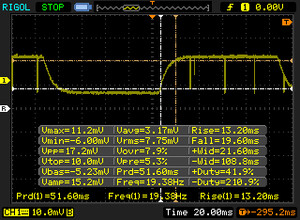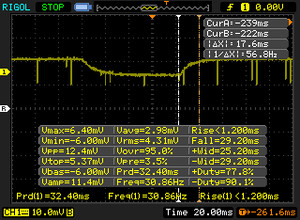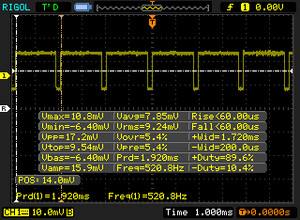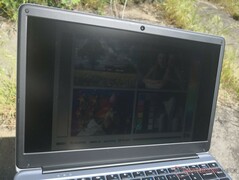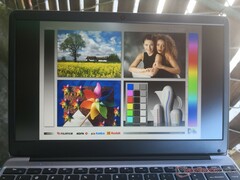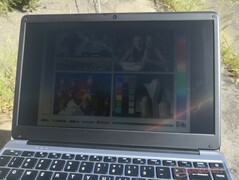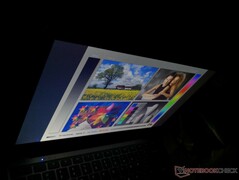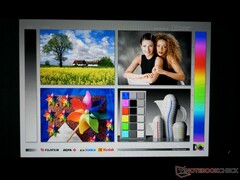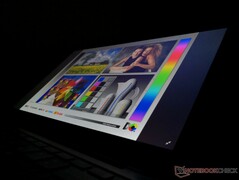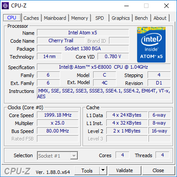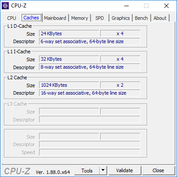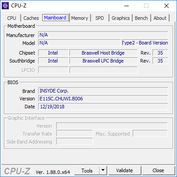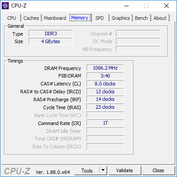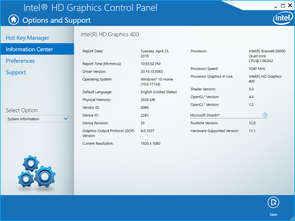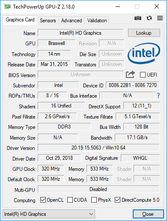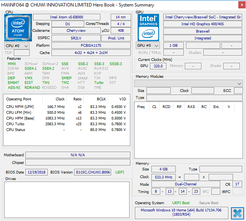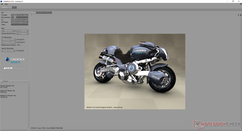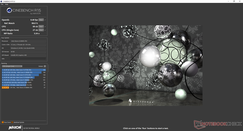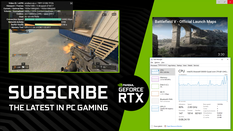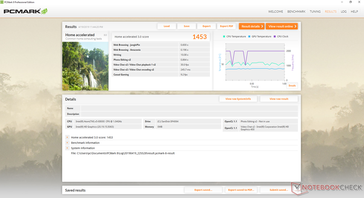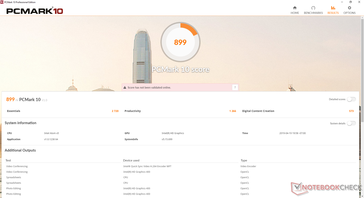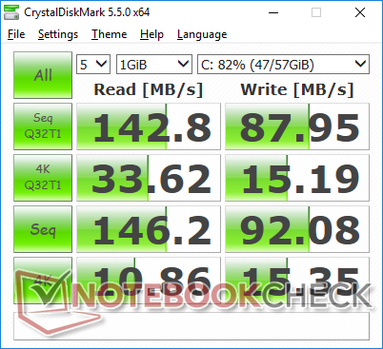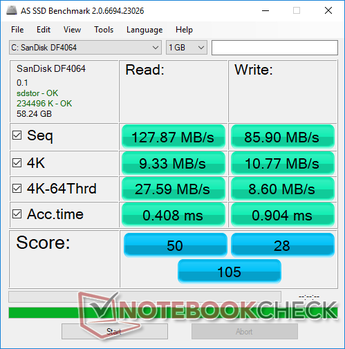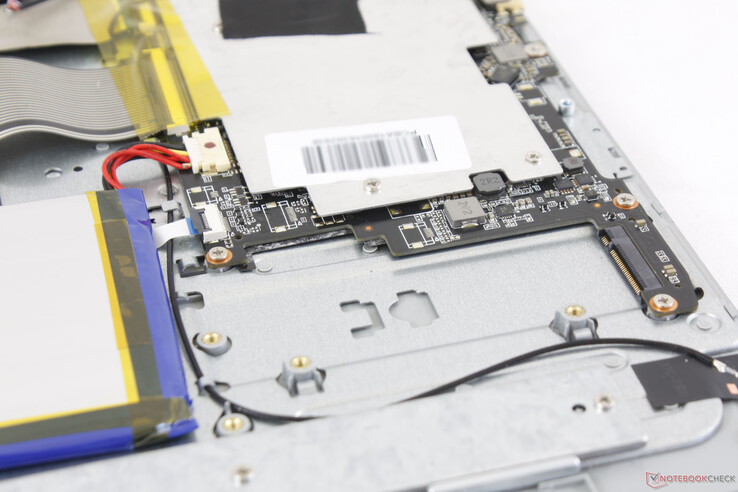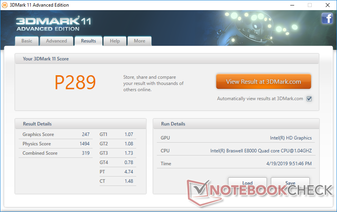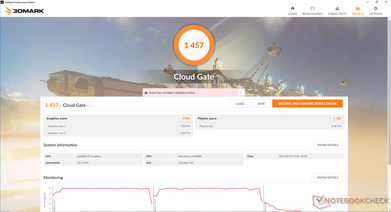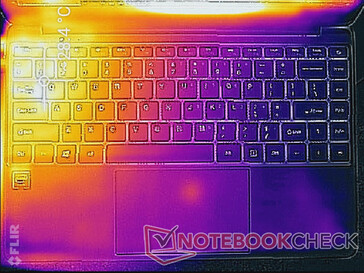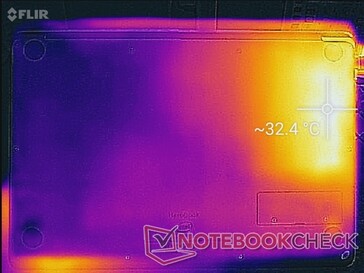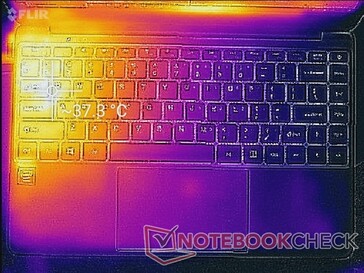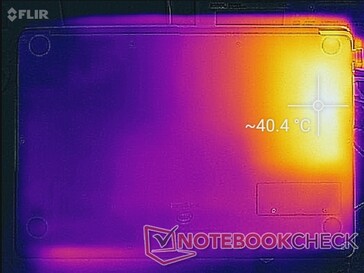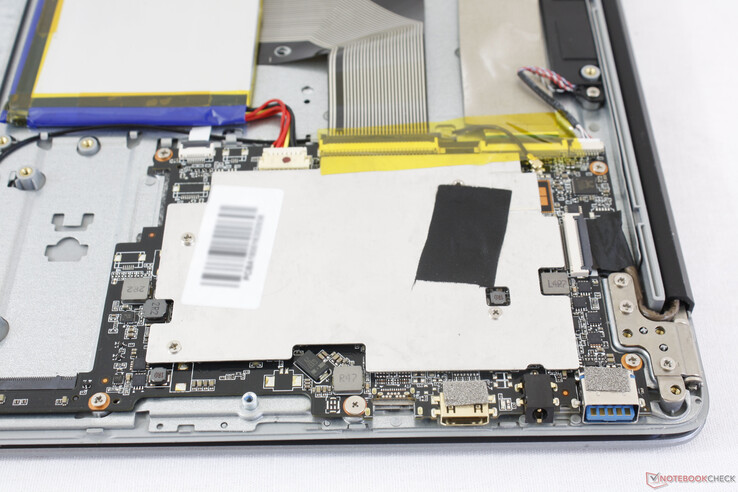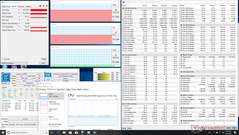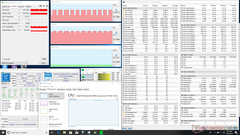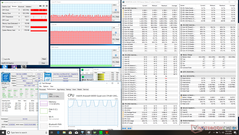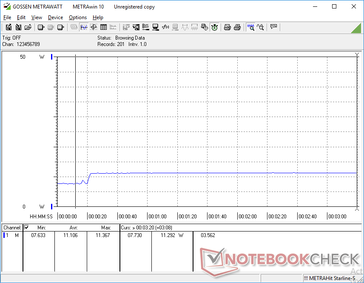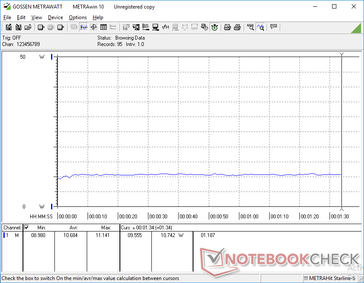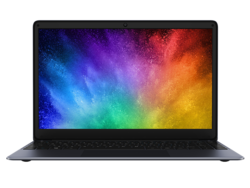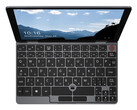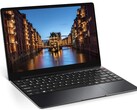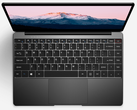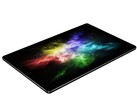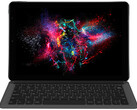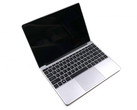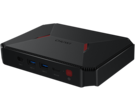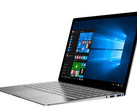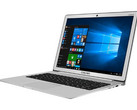Chuwi HeroBook 14 (Atom x5-E8000, FHD) Laptop Review
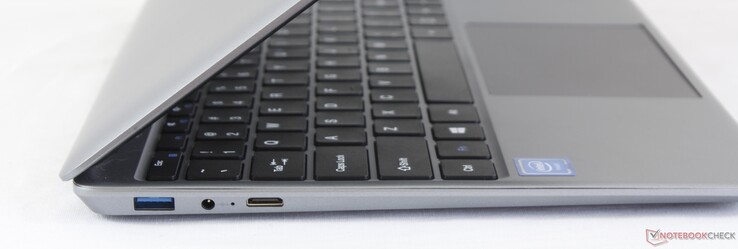
Chinese manufacturer Chuwi specializes in inexpensive laptops, tablets, and mini PCs that often retail for several hundred dollars less than mid-range ultrabooks while sporting thin and attractive chassis designs. The OEM is able to accomplish this by aiming for lower specifications that often include soldered RAM, soldered storage, and the Intel Atom or Celeron family of processors to reduce costs as much as possible. While demanding users may find the cut corners to be a bit too much, the mediocre performance of Chuwi devices should be sufficient for word processing and other light tasks.
The system we'll be checking out today is the Chuwi HeroBook netbook retailing for about $250 USD with the a 14-inch FHD display, 4 GB of LPDDR3 RAM, 64 GB SSD, and an uncommon Atom x5-E8000 SoC. The model competes directly with other inexpensive 14-inch laptops including the Lenovo V130, HP 14, and the Acer Swift 1.
See the official product page for the HeroBook here. The 768p SKU is currently on Amazon for $200.
More Chuwi reviews:
Case
The chassis is nearly identical to the two-year old LapBook Air 14.1 and so many of our comments on the LapBook Air 14.1 apply here. Both the plastic lid and base are more flexible than most flagship Ultrabooks including the XPS 13, Spectre 13, and ZenBook series. When compared to other budget or mid-range models like the Asus VivoBook or HP Pavilion, however, the Chuwi HeroBook feels on par in terms of rigidity. Moderate bending or twisting will cause slight but audible creaking.
Hinge rigidity is not uniform as it becomes weaker at wider angles. Nonetheless, teetering is not an issue when typing.
Size and weight are not all that different from other 14-inch laptops despite costing much less. Even so, the system is slightly thicker than many of the alternatives listed below including the LapBook Air 14.1.
Connectivity
Available ports are limited and even dated. Our configuration includes no USB Type-C and it still relies on a proprietary AC adapter for charging in contrast to the latest Ultrabooks in the market. Meanwhile, owners will have to invest in a mini HDMI cable or adapter as the Herobook does not integrate the more common full-size HDMI port. Port positioning is otherwise excellent and evenly distributed along both sides of the laptop.
SD Card Reader
Transfer rates from the spring-loaded MicroSD card reader are slow. Moving 1 GB of images from our UHS-II test card to desktop takes about 49 seconds compared to just 6 or 7 seconds on the XPS 13.
A fully inserted card sits flush against the edge of the system for safe transporting.
| SD Card Reader | |
| average JPG Copy Test (av. of 3 runs) | |
| HP Pavilion 14-ce0002ng (Toshiba Exceria Pro SDXC 64 GB UHS-II) | |
| Lenovo IdeaPad 530s-14IKB (Toshiba Exceria Pro SDXC 64 GB UHS-II) | |
| Asus VivoBook Flip 14 TP412UA-EC969T (Toshiba Exceria Pro SDXC 64 GB UHS-II) | |
| Chuwi HeroBook 14 (Toshiba Exceria Pro M501 64 GB UHS-II) | |
| maximum AS SSD Seq Read Test (1GB) | |
| HP Pavilion 14-ce0002ng (Toshiba Exceria Pro SDXC 64 GB UHS-II) | |
| Asus VivoBook Flip 14 TP412UA-EC969T (Toshiba Exceria Pro SDXC 64 GB UHS-II) | |
| Lenovo IdeaPad 530s-14IKB (Toshiba Exceria Pro SDXC 64 GB UHS-II) | |
| Chuwi HeroBook 14 (Toshiba Exceria Pro M501 64 GB UHS-II) | |
Communication
WLAN is limited to 802.11n with integrated Bluetooth 4.0 for slower speeds by more than a factor of 10 when compared to most Ultrabooks. Nonetheless, we experienced no connectivity issues when browsing or streaming 1080p video.
| Networking | |
| iperf3 transmit AX12 | |
| Huawei MateBook D 14 W50F | |
| Asus VivoBook Flip 14 TP412UA-EC969T | |
| HP Pavilion 14-ce0002ng | |
| Chuwi HeroBook 14 | |
| iperf3 receive AX12 | |
| Huawei MateBook D 14 W50F | |
| Asus VivoBook Flip 14 TP412UA-EC969T | |
| HP Pavilion 14-ce0002ng | |
| Chuwi HeroBook 14 | |
Maintenance
The bottom panel is secured by 14 Philips screws with four of them hidden underneath the rubber feet. Though the plastic panel is easy to remove, it certainly takes some patience. The only upgradeable component is the M.2 slot for secondary storage. The primary SSD, RAM, and WLAN are all soldered onto the board.
While much of the space inside is empty, we can appreciate the metal plating around the battery to improve rigidity.
Accessories and Warranty
There are no extras in the box other than the European-style AC charger. Users in the U.S. may need to invest in an adapter.
The standard one-year limited warranty applies. Since the Chuwi service center is overseas, users in U.S. or Europe may have to pay for international shipping if repairs are required.
Note that a sticker must be broken in order to remove the bottom panel which may impact the manufacturer warranty. Thankfully, the M.2 slot is accessible without needing to tear the sticker.
Input Devices
Keyboard and Touchpad
Key clatter is moderately loud with firm feedback and shallow travel when pressed. At the same time, however, the keys can also feel spongy towards the center because the keyboard surface flexes easily. Pushing down on a key towards the center visibly depresses the surface surrounding it compared to the more rigid keyboard bases of most other Ultrabooks. It takes some getting used to if coming from a desktop keyboard.
Perhaps unsurprisingly, there is no keyboard backlighting option. Still, we appreciate the fact that the keys are large including the Arrow keys that are often reduced in size on most other netbooks.
The clickpad (12.5 x 8 cm) is surprisingly large considering the small screen size and even larger than the clickpad on the Dell XPS 15 (10.5 x 8.5 cm). Cursor control is responsive with no jumping as one would expect. Glide is good when moving a finger across the smooth surface at medium to fast speeds, but the finger tends to stick when moving at slow speeds. The integrated mouse keys offer shallow travel, firm feedback, and a satisfying audible click when pressed.
Display
Display options include 768p or 1080p depending on the SKU. Our specific test unit is the latter with an InfoVision IVO057D IPS panel. This panel is unusual when compared to more common panels from AU Optronics or Chi Mei because it offers both a high contrast ratio and a narrow color space. Thus, while black levels are good, colors are not as deep or vivid when compared to the displays on most flagship Ultrabooks.
Perhaps the biggest drawback of the HeroBook display is its meager maximum brightness of only 215 nits compared to 250 to 300 nits on other budget laptops. While acceptable for indoor conditions, the low brightness becomes apparent when outdoors.
Another unusual property of the display is the presence of pulse-width modulation even when on the maximum brightness setting. Users sensitive to onscreen flickering may want to avoid the HeroBook as a result.
The matte panel is slightly grainy and so onscreen content does not appear as crisp as on a glossy display.
| |||||||||||||||||||||||||
Brightness Distribution: 82 %
Center on Battery: 213.6 cd/m²
Contrast: 1187:1 (Black: 0.18 cd/m²)
ΔE Color 5.78 | 0.5-29.43 Ø5, calibrated: 4.2
ΔE Greyscale 4.6 | 0.57-98 Ø5.3
57.5% sRGB (Argyll 1.6.3 3D)
36.5% AdobeRGB 1998 (Argyll 1.6.3 3D)
39.72% AdobeRGB 1998 (Argyll 2.2.0 3D)
57.8% sRGB (Argyll 2.2.0 3D)
38.43% Display P3 (Argyll 2.2.0 3D)
Gamma: 2
| Chuwi HeroBook 14 InfoVision IVO057D, IPS, 14.00, 1920x1080 | Asus VivoBook Flip 14 TP412UA-EC969T AU Optronics B140HAN04.0, IPS, 14.00, 1920x1080 | Huawei MateBook D 14 W50F BOE0764 / TV140FHM-NH0, IPS, 14.00, 1920x1080 | HP Pavilion 14-ce0002ng BOE072C, IPS, 14.00, 1920x1080 | Lenovo IdeaPad 530s-14IKB AUO B140QAN02.3, IPS, 14.00, 2560x1440 | Acer Swift 3 SF314-55-31N8 Chi Mei N140HCE-EN2, IPS, 14.00, 1920x1080 | |
|---|---|---|---|---|---|---|
| Display | 3% | 12% | 3% | 67% | 71% | |
| Display P3 Coverage | 38.43 | 39.56 3% | 43.19 12% | 39.64 3% | 65.5 70% | 66.2 72% |
| sRGB Coverage | 57.8 | 59.5 3% | 64 11% | 59.3 3% | 96.2 66% | 98.3 70% |
| AdobeRGB 1998 Coverage | 39.72 | 40.88 3% | 44.62 12% | 40.96 3% | 66.1 66% | 67.8 71% |
| Response Times | 2% | -30% | -23% | -30% | 1564% | |
| Response Time Grey 50% / Grey 80% * | 35.6 ? | 40 ? -12% | 41 ? -15% | 40 ? -12% | 58.4 ? -64% | 41 ? -15% |
| Response Time Black / White * | 32.8 ? | 28 ? 15% | 37 ? -13% | 31 ? 5% | 31.2 ? 5% | 30 ? 9% |
| PWM Frequency | 521 ? | 200 ? -62% | 200 ? -62% | 25000 ? 4698% | ||
| Screen | 12% | 1% | 1% | 24% | 24% | |
| Brightness middle | 213.6 | 251 18% | 291 36% | 239 12% | 311 46% | 291 36% |
| Brightness | 197 | 242 23% | 276 40% | 223 13% | 293 49% | 276 40% |
| Brightness Distribution | 82 | 87 6% | 85 4% | 88 7% | 85 4% | 90 10% |
| Black Level * | 0.18 | 0.25 -39% | 0.46 -156% | 0.27 -50% | 0.2 -11% | 0.27 -50% |
| Contrast | 1187 | 1004 -15% | 633 -47% | 885 -25% | 1555 31% | 1078 -9% |
| Colorchecker dE 2000 * | 5.78 | 4.03 30% | 4.3 26% | 5.3 8% | 6 -4% | 3.86 33% |
| Colorchecker dE 2000 max. * | 19.89 | 7.33 63% | 10.01 50% | 10.03 50% | 11.6 42% | 8.26 58% |
| Colorchecker dE 2000 calibrated * | 4.2 | 4.46 -6% | 3.18 24% | 3.64 13% | 1.6 62% | |
| Greyscale dE 2000 * | 4.6 | 2.55 45% | 4.21 8% | 5.85 -27% | 8.7 -89% | 5.33 -16% |
| Gamma | 2 110% | 2.48 89% | 2.46 89% | 2.45 90% | 2.19 100% | 2.25 98% |
| CCT | 7481 87% | 6831 95% | 6867 95% | 7169 91% | 8426 77% | 7426 88% |
| Color Space (Percent of AdobeRGB 1998) | 36.5 | 38 4% | 41 12% | 38 4% | 60.9 67% | 62 70% |
| Color Space (Percent of sRGB) | 57.5 | 59 3% | 64 11% | 59 3% | 96 67% | 98 70% |
| Total Average (Program / Settings) | 6% /
9% | -6% /
-3% | -6% /
-3% | 20% /
25% | 553% /
322% |
* ... smaller is better
Color space is narrow at just 58 percent of sRGB to indicate a budget panel. Other inexpensive 14-inch laptops, like the HP Pavilion 14 and Huawei MateBook D, exhibit similar color spaces to our Chuwi. Colors are noticeably shallower when compared to mainstream smartphones or pricier Ultrabooks as a result.
Further measurements with an X-Rite spectrophotometer reveal an overly cool color temperature as is typical on cheap laptop displays. Our calibration addresses this directly to improve grayscale and overall colors. Color accuracy, however, is still ultimately limited by the narrow color space. The color blue in particular is represented more inaccurately than the other colors by far.
Display Response Times
| ↔ Response Time Black to White | ||
|---|---|---|
| 32.8 ms ... rise ↗ and fall ↘ combined | ↗ 13.2 ms rise | |
| ↘ 19.6 ms fall | ||
| The screen shows slow response rates in our tests and will be unsatisfactory for gamers. In comparison, all tested devices range from 0.1 (minimum) to 240 (maximum) ms. » 87 % of all devices are better. This means that the measured response time is worse than the average of all tested devices (21.5 ms). | ||
| ↔ Response Time 50% Grey to 80% Grey | ||
| 35.6 ms ... rise ↗ and fall ↘ combined | ↗ 18 ms rise | |
| ↘ 17.6 ms fall | ||
| The screen shows slow response rates in our tests and will be unsatisfactory for gamers. In comparison, all tested devices range from 0.2 (minimum) to 636 (maximum) ms. » 44 % of all devices are better. This means that the measured response time is similar to the average of all tested devices (33.7 ms). | ||
Screen Flickering / PWM (Pulse-Width Modulation)
| Screen flickering / PWM detected | 521 Hz | ≤ 100 % brightness setting | |
The display backlight flickers at 521 Hz (worst case, e.g., utilizing PWM) Flickering detected at a brightness setting of 100 % and below. There should be no flickering or PWM above this brightness setting. The frequency of 521 Hz is quite high, so most users sensitive to PWM should not notice any flickering. In comparison: 53 % of all tested devices do not use PWM to dim the display. If PWM was detected, an average of 17900 (minimum: 5 - maximum: 3846000) Hz was measured. | |||
Outdoor visibility is poor under most conditions as the backlit is relatively dim. Colors become washed out immediately if under sunlight and text is still hard to read under shade. The HeroBook makes for a poor outdoor laptop despite its small size, matte overlay, and light weight.
Viewing angles are excellent with only minor changes in color and contrast when viewing from obtuse angles. Apparent brightness drops noticeably to make outdoor use even more difficult when trying to avoid glare.
Performance
Processor
CPU performance is very slow even for a netbook. The Atom x5-E8000 is about 30 percent slower than the Celeron N3450 found on the 2017 LapBook Air 14.1 and even slower than the Core m3-6Y30 and generations old AMD A12-9800B. This 5 W processor begins to struggle during light multi-tasking loads.
Playback of 1080p60 content is smooth with no hiccups. CPU utilization is relatively constant at about 60 percent depending on the bit rate. However, don't expect to multi-task at all during video playback as the system will grind to a halt.
See our dedicated page on the Atom x5-E8000 for more technical information and benchmark comparisons.
System Performance
PCMark benchmarks rank our Chuwi significantly slower than other Celeron or Atom-based devices. Even Chuwi's own GBox mini PC with the Celeron N4100 is able to outscore the HeroBook by over over 50 percent. The slow system performance is very noticeable during day-to-day loads through long load times and pauses when launching applications or even browsing between multiple tabs.
| PCMark 8 - Home Score Accelerated v2 | |
| Asus VivoBook Flip 14 TP412UA-EC969T | |
| Acer Swift 3 SF314-55-31N8 | |
| Lenovo Tablet 10-20L3000KGE | |
| Chuwi HeroBook 14 | |
| PCMark 8 Home Score Accelerated v2 | 1453 points | |
| PCMark 10 Score | 899 points | |
Help | ||
Storage Devices
Chuwi appears to source the same 64 GB SanDisk DF4064 solution across most of its consumer devices. The soldered SSD is very slow with its average sequential read rate of only 128 MB/s compared to ~500 MB/s on most traditional SATA III solutions. Users can expand the storage by adding a secondary M.2 2242 or 2280 SSD. See our table of SSDs and HDDs for more benchmark comparisons.
| Chuwi HeroBook 14 SanDisk DF4064 | Asus VivoBook Flip 14 TP412UA-EC969T SanDisk SD9SN8W256G1002 | HP Pavilion 14-ce0002ng SanDisk X600 SD9SN8W-128G | Acer Swift 3 SF314-55-31N8 Kingston RBUSNS8154P3128GJ | Lenovo G510 59-406675 Seagate Momentus SpinPoint M8 ST1000LM024 HN-M101MBB | |
|---|---|---|---|---|---|
| AS SSD | 582% | 300% | 976% | -589% | |
| Seq Read | 127.9 | 454.4 255% | 481.4 276% | 1201 839% | 103.4 -19% |
| Seq Write | 85.9 | 380.2 343% | 110.1 28% | 434.5 406% | 89.9 5% |
| 4K Read | 9.33 | 26.69 186% | 31.49 238% | 40.9 338% | 0.43 -95% |
| 4K Write | 10.77 | 51.1 374% | 62.6 481% | 90 736% | 0.32 -97% |
| 4K-64 Read | 27.59 | 369.5 1239% | 221.8 704% | 425.5 1442% | 0.7 -97% |
| 4K-64 Write | 8.6 | 136.8 1491% | 46.82 444% | 390.9 4445% | 0.34 -96% |
| Access Time Read * | 0.408 | 0.134 67% | 0.394 3% | 0.184 55% | 17.5 -4189% |
| Access Time Write * | 0.904 | 0.606 33% | 0.845 7% | 0.048 95% | 16.06 -1677% |
| Score Read | 50 | 442 784% | 301 502% | 586 1072% | 11 -78% |
| Score Write | 28 | 226 707% | 120 329% | 524 1771% | 10 -64% |
| Score Total | 105 | 898 755% | 570 443% | 1386 1220% | 26 -75% |
| Copy ISO MB/s | 59 | 339.5 475% | 135.2 129% | 310.1 426% | |
| Copy Program MB/s | 15.61 | 145 829% | 80.7 417% | 88.4 466% | |
| Copy Game MB/s | 37.2 | 265.6 614% | 111.5 200% | 166.4 347% |
* ... smaller is better
GPU Performance
| 3DMark 06 Standard Score | 2474 points | |
| 3DMark 11 Performance | 289 points | |
| 3DMark Cloud Gate Standard Score | 1457 points | |
Help | ||
| low | med. | high | ultra | |
| BioShock Infinite (2013) | 7.18 | 6.23 | 1.8 |
Emissions
Temperature
Surface temperatures are always warmer towards the left half of the chassis because of the positioning of the motherboard inside. When the system is idling, the warm spot can be as high as 28 C compared to just 20 C on the right half of the chassis. While the temperature difference is noticeable when typing, it never becomes uncomfortable. Users won't need to worry about accidentally blocking any ventilation grilles since the silent system is passively cooled.
Stress Test
We stress the laptop with synthetic loads to identify for any potential throttling or stability issues. When running Prime95 to stress the processor, clock rates eventually cycle between 1 GHz and 2 GHz with a cycling core temperature of 64 C and 75 C to match. When considering that the base clock rate of the Atom x5-E8000 is 1 GHz, it's good to see that the processor can periodically boost up to its maximum of 2 GHz.
Running on battery will not throttle CPU or GPU power. A 3DMark 11 test on batteries returns very similar scores to the same test on AC power.
| CPU Clock (GHz) | GPU Clock (MHz) | Average CPU Temperature (°C) | |
| System Idle | -- | -- | 52 |
| Prime95 Stress | 1.0 - 2.0 | -- | 64 - 75 |
| Prime95 + FurMark Stress | 0.56 - 1.12 | 320 | 74 |
(+) The maximum temperature on the upper side is 37.2 °C / 99 F, compared to the average of 34.2 °C / 94 F, ranging from 21.2 to 62.5 °C for the class Office.
(±) The bottom heats up to a maximum of 40.2 °C / 104 F, compared to the average of 36.7 °C / 98 F
(+) In idle usage, the average temperature for the upper side is 22.3 °C / 72 F, compared to the device average of 29.5 °C / 85 F.
(+) The palmrests and touchpad are cooler than skin temperature with a maximum of 26.4 °C / 79.5 F and are therefore cool to the touch.
(±) The average temperature of the palmrest area of similar devices was 27.7 °C / 81.9 F (+1.3 °C / 2.4 F).
Speakers
Audio is poor with the "tin can" quality common amongst many small laptops and cheap netbooks. Our microphone measurements reveal a roll off at about 1.5 KHz to suggest very poor bass reproduction. While relatively loud and sufficient for voice chat, earphones are recommend for multimedia playback.

Chuwi HeroBook 14 audio analysis
(±) | speaker loudness is average but good (75.9 dB)
Bass 100 - 315 Hz
(-) | nearly no bass - on average 24.1% lower than median
(+) | bass is linear (2.4% delta to prev. frequency)
Mids 400 - 2000 Hz
(±) | higher mids - on average 7.8% higher than median
(-) | mids are not linear (18.1% delta to prev. frequency)
Highs 2 - 16 kHz
(±) | higher highs - on average 10.5% higher than median
(-) | highs are not linear (15.9% delta to prev. frequency)
Overall 100 - 16.000 Hz
(-) | overall sound is not linear (47.1% difference to median)
Compared to same class
» 99% of all tested devices in this class were better, 0% similar, 0% worse
» The best had a delta of 7%, average was 22%, worst was 53%
Compared to all devices tested
» 95% of all tested devices were better, 0% similar, 5% worse
» The best had a delta of 4%, average was 25%, worst was 134%
Apple MacBook 12 (Early 2016) 1.1 GHz audio analysis
(+) | speakers can play relatively loud (83.6 dB)
Bass 100 - 315 Hz
(±) | reduced bass - on average 11.3% lower than median
(±) | linearity of bass is average (14.2% delta to prev. frequency)
Mids 400 - 2000 Hz
(+) | balanced mids - only 2.4% away from median
(+) | mids are linear (5.5% delta to prev. frequency)
Highs 2 - 16 kHz
(+) | balanced highs - only 2% away from median
(+) | highs are linear (4.5% delta to prev. frequency)
Overall 100 - 16.000 Hz
(+) | overall sound is linear (10.2% difference to median)
Compared to same class
» 5% of all tested devices in this class were better, 2% similar, 93% worse
» The best had a delta of 5%, average was 19%, worst was 53%
Compared to all devices tested
» 3% of all tested devices were better, 1% similar, 96% worse
» The best had a delta of 4%, average was 25%, worst was 134%
Energy Management
Power Consumption
Idling on desktop demands anywhere from 4 W to 7 W depending on the brightness level and power profile to be similar to many other 14-inch laptops powered by more powerful Intel U-class CPUs. The difference becomes more noticeable when under heavier processing loads. Running 3DMark 06, for examples, draws about 11 W compared to ~30 W from the more powerful Asus VivoBook Flip 14 or Huawei MateBook D 14.
We're able to record a maximum draw of 14.6 W from the small (~8 x 4.3 x 2.7 cm) 24 W AC adapter.
| Off / Standby | |
| Idle | |
| Load |
|
| Chuwi HeroBook 14 E8000, HD Graphics 400 (Braswell), SanDisk DF4064, IPS, 1920x1080, 14.00 | Asus VivoBook Flip 14 TP412UA-EC969T i3-8130U, UHD Graphics 620, SanDisk SD9SN8W256G1002, IPS, 1920x1080, 14.00 | Huawei MateBook D 14 W50F i5-8250U, UHD Graphics 620, SanDisk SD9SN8W256G1027, IPS, 1920x1080, 14.00 | HP Pavilion 14-ce0002ng i5-8550U, GeForce MX150, SanDisk X600 SD9SN8W-128G, IPS, 1920x1080, 14.00 | Acer Swift 3 SF314-55-31N8 i3-8145U, UHD Graphics 620, Kingston RBUSNS8154P3128GJ, IPS, 1920x1080, 14.00 | Lenovo Tablet 10-20L3000KGE Celeron N4100, UHD Graphics 600, 128 GB eMMC Flash, IPS, 1920x1200, 10.10 | |
|---|---|---|---|---|---|---|
| Power Consumption | -81% | -69% | -188% | -52% | -5% | |
| Idle Minimum * | 4 | 2.8 30% | 3.7 7% | 6.3 -58% | 2.9 27% | 3.5 12% |
| Idle Average * | 6.3 | 5.4 14% | 6.9 -10% | 8.4 -33% | 5.6 11% | 5.6 11% |
| Idle Maximum * | 7 | 8.4 -20% | 8.4 -20% | 10.2 -46% | 6.1 13% | 6.4 9% |
| Load Average * | 10.7 | 38 -255% | 32 -199% | 59 -451% | 29 -171% | 15.1 -41% |
| Load Maximum * | 14.6 | 40.3 -176% | 32.6 -123% | 66.3 -354% | 35.3 -142% | 17.3 -18% |
* ... smaller is better
Battery Life
Runtimes from the small 38 Wh battery are average at about 6 hours of real-world WLAN use. Other 14-inch laptops like the Lenovo IdeaPad 530s tend to last one or two hours longer despite carrying more powerful processors.
Charging from empty to full capacity is slow at about 2 to 2.5 hours.
| Chuwi HeroBook 14 E8000, HD Graphics 400 (Braswell), 38 Wh | Asus VivoBook Flip 14 TP412UA-EC969T i3-8130U, UHD Graphics 620, 42 Wh | Huawei MateBook D 14 W50F i5-8250U, UHD Graphics 620, 57 Wh | HP Pavilion 14-ce0002ng i5-8550U, GeForce MX150, 41 Wh | Lenovo IdeaPad 530s-14IKB i5-8550U, GeForce MX150, 45 Wh | Acer Swift 3 SF314-55-31N8 i3-8145U, UHD Graphics 620, 50.7 Wh | |
|---|---|---|---|---|---|---|
| Battery Runtime | 12% | 62% | 13% | 41% | 67% | |
| WiFi v1.3 | 368 | 412 12% | 597 62% | 414 13% | 520 41% | 614 67% |
| Reader / Idle | 1414 | 797 | 881 | |||
| Load | 129 | 145 | 85 |
Pros
Cons
Verdict
The Chuwi HeroBook has a handful of respectable qualities worth mentioning. Its large keyboard keys, large clickpad, compact design, high contrast ratio, expandable M.2 storage, and 1080p screen are often better than what you'd typically find in the budget $500 range. We applaud Chuwi for offering a visually appealing laptop at such a low starting price.
Of course, a cheap and good-looking laptop can only get you so far if the hardware inside can't perform. In this case, the HeroBook is dragged down by the dreadfully slow Atom processor and soldered SSD. We're certainly not expecting first-class performance, but it becomes difficult to recommend a laptop when it struggles during even the most basic of tasks like web browsing, word processing, or minimal multi-tasking. As a result, the HeroBook is best used as a secondary backup laptop for very light office work or video streaming where multi-tasking is not priority.
The Atom processor is notoriously slow when it comes to multi-tasking. Nonetheless, the very inexpensive Chuwi HeroBook offers a decent experience when it comes to runtimes, word processing, and video playback with its respectable 1080p screen.
Chuwi HeroBook 14
-
09/26/2019 v7
Allen Ngo


 Deutsch
Deutsch English
English Español
Español Français
Français Italiano
Italiano Nederlands
Nederlands Polski
Polski Português
Português Русский
Русский Türkçe
Türkçe Svenska
Svenska Chinese
Chinese Magyar
Magyar